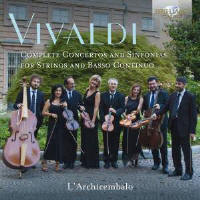Texte paru dans: / Appeared in: Brilliant Classics |
|
|
Reviewer: Bertil
van Boer In the period 1720–1740 generic distinctions in instrumental music were nowhere as strict as they are even a few years later. The main division was between concertante music, usually in a chamber setting, and the ripieno, which meant something a bit better staffed. Of course, few if any composers designated music according to this division, save in the concerto grosso, where the concertino and ripieno was a necessary point. For Antonio Vivaldi, the generic designation is further confused, as he often calls works concerto a quattro, concerto ripieno, sinfonia, or concerto sinfonia. For example, a large-scale composition arranged for the 1738 Amsterdam Centennial concert (RV 562a) was called in the program a symphony, but on the manuscript a concerto, and though it is set rather thickly, with timpani, brass (horns, but originally performed with trumpets), oboes, bassoons, and strings, there is an extensive obbligato solo violin. Whatever he used to designate these works generically, one finds a substantial number that span four discs in this complete set.
All of these concertos have been recorded in some form or another over the past years, and one is probably familiar with Vivaldi’s style and structure. It has often been a base canard that the composer wrote one concerto about 600 times, and one cannot dismiss the notion that he forged his own distinctive style. But this style became instantly recognizable during his lifetime, and others such as Johann Sebastian Bach sought out the music as a model. Not surprisingly, this recognition played an important role in the development of a new orchestral format that eventually became the symphony. Indeed, Vivaldi himself indulged in the instrumental sinfonia, which the booklet notes “derive from the opera symphony [sic].” To be sure, this is the origin, but one might consider that Vivaldi was well aware that the new genre of the symphony was emerging in concert settings and that these works were representative of others of his time in that they had little connection to the theater at all.
Given the large number of works in this four-disc set and the purpose of being comprehensive, it seems difficult to give examples, lest one be accused of playing favorites among so substantial a repertory. Tutti o niente, as one might say. Still, they are not all of a same pattern with slightly differing colors. The composer occasionally does do some quirky things, like the B Concerto (RV 163) in which the violins imitate a conch horn in the first and last movements; here, there is even a suggestion that this may actually have been written for a shell instrument, but redone with strings because both instruments and performers were unique. In the D-Minor Concerto, subtitled “madrigalesco,” one has a more old-fashioned work, unusual in that it is in four movements. The nod to Corelli could not be more plain in the solemn opening chords, the rather gnarly contrapuntal second movement, the mysterious, even sacred-sounding third, and the rather relentless finale. The contrapuntal movements may have a hint of the madrigal about them in the voice leading and sometimes close harmonies, but it is a bit harder to fathom his designation. And so it goes, one nice energetic work after the next.
The
performance by L’Archicembalo is smooth and filled with energy. They seem to
know how to phrase his various sequences, and there is a nice rawness about
the unisons as well as a lush texture when needed. In short, these four
discs are not just an archival presentation of the complete string concertos
and sinfonias; they are a good solid four hours plus of listening that will
take one away to 18th-century Venice and beyond. | |
|
|
|
|
|
|
|
Cliquez l'un ou l'autre
bouton pour découvrir bien d'autres critiques de CD |
|




